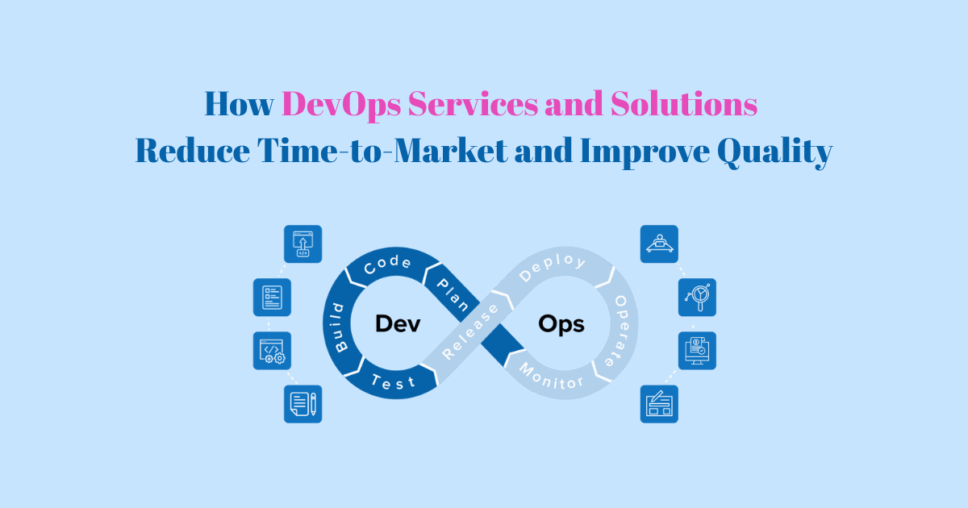In a fiercely competitive digital economy, speed and quality are the two non-negotiables for successful software development. Whether you’re a startup building your MVP or an enterprise modernizing legacy systems, the pressure to deliver faster and better is immense. This is where DevOps Services and Solutions emerge as a game-changer.
This blog explores how DevOps not only accelerates time-to-market but also elevates software quality, leading to streamlined operations, reduced costs, and enhanced customer satisfaction.
Understanding DevOps Services and Solutions
DevOps is a cultural and technical movement that integrates development (Dev) and operations (Ops) teams to improve collaboration, automation, and agility in the software lifecycle. DevOps Services and Solutions encompass the consulting, implementation, tools, and support required to adopt DevOps practices efficiently.
Key components of DevOps Services and Solutions include:
- CI/CD Implementation: Automates code integration, testing, and deployment for faster releases.
- Infrastructure Automation: Uses code to set up and manage infrastructure quickly and reliably.
- Configuration Management: Keeps system settings and environments consistent across servers.
- Containerization & Orchestration: Runs apps in containers (e.g., Docker) and manages them with tools like Kubernetes.
- Security Integration (DevSecOps): Adds automated security checks into the development pipeline.
- Monitoring and Logging: Tracks system health and logs issues for quick problem resolution.
- Cloud-Native Transformation: Builds scalable apps optimized for cloud environments.
These services are designed to break down silos, promote shared ownership, and drive rapid and reliable delivery of software.
Traditional Software Delivery Challenges
Before DevOps, software delivery was often slow and prone to quality issues due to:
- Long release cycles (monthly or quarterly): Slow software updates that delay new features and bug fixes.
- Manual infrastructure provisioning: Time-consuming setup of servers and resources without automation.
- Lack of collaboration between Dev and Ops teams: Poor communication leading to delays and inefficiencies.
- Delayed testing and feedback: Late discovery of bugs due to slow or manual testing processes.
- Siloed workflows and responsibilities: Teams work in isolation, causing coordination issues and slower delivery.
These challenges led to frequent production issues, low deployment frequency, and delayed customer feedback — significantly increasing time-to-market.
How DevOps Reduces Time-to-Market
DevOps drastically shortens delivery timelines by automating and streamlining every phase of the software development lifecycle (SDLC). Let’s explore how.
Continuous Integration and Continuous Delivery (CI/CD)
- Developers frequently merge code into a shared repository.
- Automated builds and tests validate every change.
- CI/CD pipelines enable rapid and consistent deployments to staging and production.
Impact: Faster iteration cycles and reduced manual intervention speed up releases from weeks to days or even hours.
Infrastructure as Code (IaC)
- Infrastructure is provisioned and managed using code (e.g., Terraform, CloudFormation).
- Environments can be cloned, modified, and deployed in minutes.
Impact: Eliminates manual setup, reduces human error, and ensures consistent infrastructure.
Automated Testing and Monitoring
- Unit, integration, and regression tests are automated and triggered by CI tools.
- Real-time monitoring tools (like Prometheus, ELK Stack) offer performance insights.
Impact: Automation ensures early issue detection and faster feedback loops.
Parallel Workflows and Collaboration
- Shared responsibility between developers, testers, and operations teams.
- Teams use collaboration tools like Slack, Jira, and Confluence for streamlined communication.
Impact: Reduces handoff delays and improves alignment, enabling faster go-to-market.
How DevOps Improves Software Quality
DevOps not only accelerates deployment but also ensures robust and reliable software through automation, early feedback, and continuous monitoring.
Early Bug Detection
With CI/CD and test automation, bugs are caught early in development, when they are cheaper and easier to fix.
Automated Quality Gates
Quality checks (code coverage, linting, security scans) are embedded in pipelines to enforce coding standards.
Continuous Feedback Loop
Monitoring tools and customer feedback are integrated into the SDLC for real-time updates and course correction.
DevSecOps for Built-In Security
Security tools are integrated into the CI/CD pipeline to automatically scan for vulnerabilities, ensuring compliance and quality from the start.
Real-World Benefits: Case Studies and Industry Examples
Automotive Industry
A leading car manufacturer used DevOps Services and Solutions to automate its testing and deployment pipelines. As a result, software updates for in-car infotainment systems were reduced from 6 months to 2 weeks, with a 40% drop in post-release defects.
E-Commerce Sector
An online retailer adopted DevOps to handle Black Friday surges. Infrastructure provisioning was cut from hours to minutes using IaC, and incident recovery time dropped by 60%.
Banking & Finance
A fintech startup implemented CI/CD and DevSecOps to meet regulatory demands. This led to 30% faster release cycles and improved security compliance.
Key DevOps Tools That Drive Speed and Quality
| Category | Tools Used |
| CI/CD Pipelines | Jenkins, GitLab CI, CircleCI |
| Configuration Management | Ansible, Puppet, Chef |
| Containerization | Docker, Podman |
| Orchestration | Kubernetes, OpenShift |
| Monitoring & Logging | Prometheus, Grafana, ELK Stack |
| IaC | Terraform, AWS CloudFormation |
| Security | SonarQube, Snyk, Aqua Security |
DevOps Services and Solutions leverage these tools to build automated, reliable, and secure delivery pipelines.
Best Practices for Implementing DevOps Services and Solutions
- Start with a cultural shift: Embrace collaboration, transparency, and shared responsibility.
- Automate everything: From code builds to infrastructure and testing.
- Adopt CI/CD pipelines early: For quick iterations and feedback.
- Use IaC for scalability: To manage infrastructure across multiple environments.
- Monitor continuously: For performance, security, and user experience.
- Iterate and improve: Regular retrospectives and feedback loops are critical.
Challenges and Considerations
While DevOps Services and Solutions bring tremendous value, they’re not without challenges:
- Resistance to cultural change: Teams are hesitant to adopt new collaborative DevOps practices.
- Skill gaps in automation and tooling: Lack of expertise in using DevOps tools and automation methods.
- Choosing the right tools for your stack: Difficulty selecting tools that fit your tech and business needs.
- Maintaining security across the pipeline: Ensuring consistent security at every stage of development.
- Managing multi-cloud and hybrid environments: Complexity in handling diverse cloud and on-prem systems.
Partnering with experienced DevOps consultants helps mitigate these risks and accelerate transformation.
Conclusion
The modern software landscape demands rapid innovation without compromising on quality. DevOps Services and Solutions offer a structured, scalable, and efficient approach to achieving both. By automating processes, fostering collaboration, and integrating quality checks throughout the development cycle, DevOps empowers businesses to:
- Shorten release cycles
- Deliver high-quality software
- Reduce operational overhead
- Enhance user satisfaction
Whether you’re a startup seeking agility or an enterprise pursuing digital transformation, adopting DevOps Services and Solutions is not just an advantage — it’s a necessity.
FAQs
Q1: What is the primary goal of DevOps Services and Solutions?
To streamline software development and IT operations by automating workflows, enhancing collaboration, and delivering high-quality software faster.
Q2: How do DevOps Services and Solutions reduce time-to-market?
They enable rapid iterations through CI/CD, automated testing, IaC, and real-time feedback, resulting in faster deployments.
Q3: Can small businesses benefit from DevOps?
Absolutely. DevOps allows small teams to deliver faster, more reliable applications and scale efficiently as they grow.
Q4: Are DevOps and Agile the same?
No, but they complement each other. Agile focuses on iterative development, while DevOps ensures continuous delivery and deployment of those iterations.
Q5: How can I start implementing DevOps Services and Solutions?
Begin with a DevOps assessment, identify bottlenecks, automate critical processes, and work with a qualified DevOps consulting partner.





